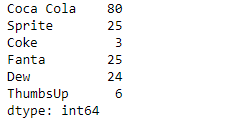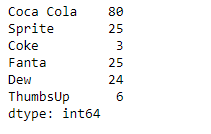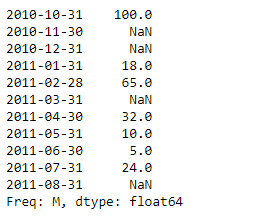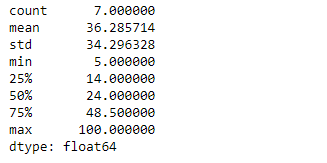Python Pandas Series.describe()
Pandas系列是一个带有轴标签的一维ndarray。标签不需要是唯一的,但必须是一个可散列的类型。该对象支持基于整数和标签的索引,并提供了大量的方法来执行涉及索引的操作。
Pandas Series.describe()函数生成一个描述性统计,总结了给定系列对象的数据集分布的中心趋势、分散度和形状。所有的计算都是通过排除NaN值进行的。
语法: Series.describe(percentiles=None, include=None, exclude=None)
参数:
percentiles:输出中包括的百分位数。
include :在结果中包含的数据类型的白名单。对系列来说是忽略的。
exclude :一个要从结果中省略的数据类型的黑名单。对系列来说是忽略的
回报:系列的统计摘要
示例#1:使用Series.describe()函数来查找给定系列对象的汇总统计。
# importing pandas as pd
import pandas as pd
# Creating the Series
sr = pd.Series([80, 25, 3, 25, 24, 6])
# Create the Index
index_ = ['Coca Cola', 'Sprite', 'Coke', 'Fanta', 'Dew', 'ThumbsUp']
# set the index
sr.index = index_
# Print the series
print(sr)
输出 :

现在我们将使用Series.describe()函数来查找给定系列对象中基础数据的汇总统计。
# find summary statistics of the underlying
# data in the given series object.
result = sr.describe()
# Print the result
print(result)
输出 :

正如我们在输出中看到的,Series.describe()函数已经成功地返回了给定系列对象的汇总统计。
示例#2 :使用Series.describe()函数来查找给定系列对象中基础数据的汇总统计。给定的系列对象包含一些缺失值。
# importing pandas as pd
import pandas as pd
# Creating the Series
sr = pd.Series([100, None, None, 18, 65, None, 32, 10, 5, 24, None])
# Create the Index
index_ = pd.date_range('2010-10-09', periods = 11, freq ='M')
# set the index
sr.index = index_
# Print the series
print(sr)
输出 :

现在我们将使用Series.describe()函数来查找给定系列对象中基础数据的汇总统计。
# find summary statistics of the underlying
# data in the given series object.
result = sr.describe()
# Print the result
print(result)
输出 :

正如我们在输出中看到的,Series.describe()函数已经成功地返回了给定系列对象的汇总统计。在计算这些统计值时,NaN值已被忽略。
 极客教程
极客教程